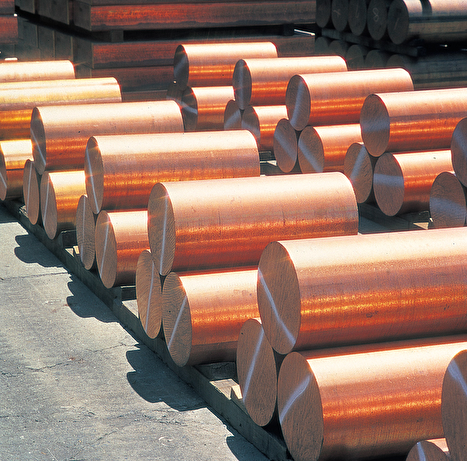Why Copper Products Are Vital for Electrical Applications and Reliable Circuitry
Why Copper Products Are Vital for Electrical Applications and Reliable Circuitry
Blog Article
Discovering the Diverse Applications of Copper Products in Modern Industries
From boosting the efficiency of electric systems to playing a critical role in sustainable energy technologies, the convenience of copper is evident. As industries progressively prioritize technology and sustainability, the varied applications of copper warrant a closer evaluation, especially concerning their prospective effect on future ecological practices and technical innovations.
Electrical Applications of Copper
Copper is an important material in the electrical industry, representing around 60% of the total demand for non-ferrous metals globally - Copper Products. Its superior electrical conductivity, which is virtually two times that of aluminum, makes it the favored selection for a vast array of electrical applications. From circuitry systems in business and residential buildings to high-voltage power transmission lines, copper ensures effectiveness and dependability in electricity shipment
In enhancement to circuitry, copper is important to the production of electrical components such as motors, generators, and transformers. These parts utilize copper's thermal conductivity and malleability, necessary for heat dissipation and effective performance. Furthermore, copper's resistance to deterioration boosts the lifespan and longevity of electrical systems, making it a cost-effective remedy in the long-term.
The growth of renewable resource resources, such as solar and wind power, has further increased the need for copper in electrical applications. As industries change in the direction of lasting energy solutions, copper's function ends up being even much more vital. Overall, the flexibility and efficiency qualities of copper strengthen its condition as a foundation material within the electrical sector, driving development and effectiveness throughout different applications.
Plumbing and Piping Solutions
In modern-day pipes systems, the option of materials substantially influences both capability and longevity. Copper has actually emerged as a preferred alternative because of its one-of-a-kind properties, consisting of deterioration resistance and antimicrobial qualities. These characteristics make sure that copper piping remains long lasting and secure for transporting drinkable water, an essential factor to consider in residential and commercial applications.
Among the crucial advantages of copper in pipes is its ability to endure heats and stress, making it ideal for a variety of applications, from warm water systems to heating and cooling networks. In addition, copper's flexibility permits less complicated installation in complex piping layouts, decreasing the danger of failings and leaks.
One more noteworthy advantage is copper's long lifespan, frequently exceeding half a century with proper upkeep. This longevity not just minimizes substitute prices however additionally contributes to lasting practices by minimizing waste. Additionally, copper's recyclability lines up with contemporary ecological criteria, promoting a circular economic climate within the pipes industry.
Copper in Renewable Resource
The versatility of copper expands past plumbing applications, playing an essential duty in the eco-friendly power industry. In solar panels, copper is made use of in photovoltaic cells and wiring, helping with reliable energy conversion and transmission.

Moreover, as the worldwide demand for electrical automobiles (EVs) boosts, copper's duty in battery systems and billing facilities becomes much more significant. The material's capability to perform power effectively is indispensable to the performance of EV batteries, enhancing variety and billing speed.
Copper's Duty in Electronic devices
Electronics manufacturing counts heavily on copper's phenomenal homes, particularly its high electric conductivity and thermal efficiency. These characteristics make copper an excellent selection for a broad range of electronic components, consisting of ports, motherboard, and electrical wiring. The steel's capacity to effectively transmit electrical signals ensures marginal power loss, which is important in high-performance digital tools.
In addition, copper's thermal conductivity plays a significant duty in warm dissipation, safeguarding delicate components from overheating. This is especially crucial in modern-day electronics, where compact layouts cause boosted warm generation. Copper is also preferred for its malleability and ductility, allowing it to be quickly shaped right into detailed layouts that fulfill the demands of advanced electronic applications.
With the rise of customer electronic devices, telecoms, and electrical automobiles, the need for copper in the electronics field continues to expand. Thus, copper stays a foundation material in the ever-expanding field of electronics.
Cutting-edge Makes Use Of in Production

One remarkable application is in additive production, where copper-based materials are employed in 3D printing processes. This permits for the development of lightweight elements and intricate geometries, particularly in the aerospace and vehicle fields. In addition, copper's thermal conductivity makes it a perfect choice for warm exchangers, boosting performance in industrial air conditioning systems.
Furthermore, the rise of wise production has seen the unification of copper in IoT gadgets, where its conductive capacities support sophisticated sensing innovations. In the realm of renewable resource, copper is essential in the manufacturing of photovoltaic panels and wind turbines, helping with extra efficient power conversion and circulation.
As sectors pursue sustainability and development, copper's flexibility and efficiency remain to position it as an essential material, driving developments in manufacturing and contributing to the growth of smarter, much more efficient products.
Final Thought
The important duty of copper in sustainable power and its important function in electronics emphasize its relevance in progressing lasting techniques. Jointly, these applications highlight copper's essential payment to technological development and commercial performance view it now in modern society.
From boosting the performance of electric systems to playing a crucial function in sustainable energy modern technologies, the versatility of copper is apparent. As markets significantly focus on innovation and sustainability, the diverse applications of copper call for a closer examination, especially concerning their prospective effect on future ecological practices and technical developments.
The growth of renewable power sources, such as solar and wind power, has actually even more raised the need for copper in electrical applications. Overall, the versatility and efficiency characteristics of copper strengthen its status as a keystone product within the electric industry, driving innovation and performance throughout different applications.
The convenience of copper expands past plumbing applications, playing a vital function in the sustainable power industry.
Report this page